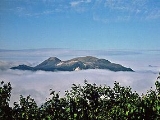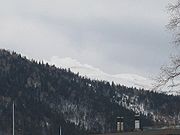
Akan Volcanic Complex
Encyclopedia
Akan Volcanic Complex is a volcanic group
of volcano
es that grew out of the Akan caldera
. It is located within Akan National Park
, about 50km Northwest of Kushiro
in eastern Hokkaidō
, Japan
.
 A number of peaks are arranged around the rim of Lake Akan
A number of peaks are arranged around the rim of Lake Akan
(aka Akan-ko), which fills a 24x 13km caldera, the tallest being Me-Akan
(Meakan), O-Akan
(Oakan) and Akan-Fuji.
 Oakan is prominently located at the Northeast side of the caldera, while Meakan occupies the opposite, Southwest side, in a cluster of nine stratovolcanoes that include Akan-Fuji, one of many symmetrical Japanese volcanoes named after the renowned Mount Fuji
Oakan is prominently located at the Northeast side of the caldera, while Meakan occupies the opposite, Southwest side, in a cluster of nine stratovolcanoes that include Akan-Fuji, one of many symmetrical Japanese volcanoes named after the renowned Mount Fuji
, and Fuppushi volcano (aka Fuppushi-dake, not to be confused with Mount Fuppushi
, which is located in Southwestern Hokkaido).
periods.
The Nakamachineshiri crater of Meakan volcano was formed during a major eruption about 13,500 years ago.
The Me-Akan group of nine overlapping cones on the eastern side of Lake Akan has had mild eruptions since the beginning of the 19th century. The last eruption of this historical volcano was in 2008.
Oakan, Meakan, Furebetsu and Fuppushi are the major post-caldera volcanoes of the Akan volcanic complex.
Me-Akan is one of the most active volcanoes of Hokkaido. Its summit contains the active craters of Ponmachineshiri and Naka-Machineshiri, sites of frequent phreatic
eruptions in historical time. Akan-Fuji and O-Akan have not erupted in historical time.
Akan is rated with a volcanic explosivity index
of 4 on the Smithsonian VEI scale, the scale's fourth-highest score, based on the volcano's largest known eruption, around 7050 BC.
Following are prominent features of Akan:
Volcanic group
A volcanic group is a collection of related volcanoes or volcanic landforms. Note that the term is also used in a different sense when it denotes a suite of associated rock strata largely of volcanic origin; see group for details.-Notable volcanic groups:-See also:*Complex...
of volcano
Volcano
2. Bedrock3. Conduit 4. Base5. Sill6. Dike7. Layers of ash emitted by the volcano8. Flank| 9. Layers of lava emitted by the volcano10. Throat11. Parasitic cone12. Lava flow13. Vent14. Crater15...
es that grew out of the Akan caldera
Caldera
A caldera is a cauldron-like volcanic feature usually formed by the collapse of land following a volcanic eruption, such as the one at Yellowstone National Park in the US. They are sometimes confused with volcanic craters...
. It is located within Akan National Park
Akan National Park
is a national park located on the island of Hokkaidō, Japan. Along with Daisetsuzan National Park, these are the two oldest national parks in Hokkaidō. The park was established December 4, 1934....
, about 50km Northwest of Kushiro
Kushiro, Hokkaido
is a city located in Kushiro Subprefecture, Hokkaidō, Japan. It is the capital city of Kushiro Subprefecture, as well as the most populous city in eastern Hokkaidō....
in eastern Hokkaidō
Hokkaido
, formerly known as Ezo, Yezo, Yeso, or Yesso, is Japan's second largest island; it is also the largest and northernmost of Japan's 47 prefectural-level subdivisions. The Tsugaru Strait separates Hokkaido from Honshu, although the two islands are connected by the underwater railway Seikan Tunnel...
, Japan
Japan
Japan is an island nation in East Asia. Located in the Pacific Ocean, it lies to the east of the Sea of Japan, China, North Korea, South Korea and Russia, stretching from the Sea of Okhotsk in the north to the East China Sea and Taiwan in the south...
.
Description

Lake Akan
is a lake in Kushiro, Hokkaidō, Japan. It is located in Akan National Park and is a Ramsar Site.-History:Volcanic activity formed the lake some 6,000 years ago, when a dam was formed. The lake used to have a clarity of 8–9 meters in the 1930s. Pollution from local hotspring resorts has decreased...
(aka Akan-ko), which fills a 24x 13km caldera, the tallest being Me-Akan
Mount Meakan
is an active stratovolcano located in Akan National Park in Hokkaidō, Japan. It is the tallest mountain in the Akan Volcanic Complex.The volcano consists of nine overlapping cones that grew out of the Akan caldera, on the shores of Lake Akan. Mount Meakan has a triple crater at its summit...
(Meakan), O-Akan
Mount Oakan
is a shield volcano located in Akan National Park in Hokkaidō, Japan.-Geography and geology:Mount Oakan sits in the Akan caldera northeast of Lake Akan. The volcano rises some above the surrounding terrain. The top of the volcano is above sea level. The volcanic cone is some in diameter. There...
(Oakan) and Akan-Fuji.

Mount Fuji
is the highest mountain in Japan at . An active stratovolcano that last erupted in 1707–08, Mount Fuji lies about south-west of Tokyo, and can be seen from there on a clear day. Mount Fuji's exceptionally symmetrical cone is a well-known symbol of Japan and it is frequently depicted in art and...
, and Fuppushi volcano (aka Fuppushi-dake, not to be confused with Mount Fuppushi
Mount Fuppushi
is dormant volcano located in Shikotsu-Toya National Park in Hokkaidō, Japan. It sits adjacent to Mount Tarumae and opposite Mount Eniwa. Mount Fuppushi is on the south shore of Lake Shikotsu, the caldera lake that spawned the volcanoes.-References:*...
, which is located in Southwestern Hokkaido).
Volcanology
The Akan caldera was formed 31,500 years ago. Its elongated shape is due to its incremental formation during major explosive eruptions, from the early to the mid-PleistocenePleistocene
The Pleistocene is the epoch from 2,588,000 to 11,700 years BP that spans the world's recent period of repeated glaciations. The name pleistocene is derived from the Greek and ....
periods.
The Nakamachineshiri crater of Meakan volcano was formed during a major eruption about 13,500 years ago.
The Me-Akan group of nine overlapping cones on the eastern side of Lake Akan has had mild eruptions since the beginning of the 19th century. The last eruption of this historical volcano was in 2008.
Oakan, Meakan, Furebetsu and Fuppushi are the major post-caldera volcanoes of the Akan volcanic complex.
Me-Akan is one of the most active volcanoes of Hokkaido. Its summit contains the active craters of Ponmachineshiri and Naka-Machineshiri, sites of frequent phreatic
Phreatic
The term phreatic is used in Earth sciences to refer to matters relating to ground water below the water table . The term 'phreatic surface' indicates the location where the pore water pressure is under atmospheric conditions...
eruptions in historical time. Akan-Fuji and O-Akan have not erupted in historical time.
Akan is rated with a volcanic explosivity index
Volcanic Explosivity Index
The Volcanic Explosivity Index was devised by Chris Newhall of the U.S. Geological Survey and Stephen Self at the University of Hawaii in 1982 to provide a relative measure of the explosiveness of volcanic eruptions....
of 4 on the Smithsonian VEI scale, the scale's fourth-highest score, based on the volcano's largest known eruption, around 7050 BC.
Following are prominent features of Akan:
Cones
- Mount MeakanMount Meakanis an active stratovolcano located in Akan National Park in Hokkaidō, Japan. It is the tallest mountain in the Akan Volcanic Complex.The volcano consists of nine overlapping cones that grew out of the Akan caldera, on the shores of Lake Akan. Mount Meakan has a triple crater at its summit...
(1499 m) Stratovolcano - Akan Fuji (Akan-Fuji, aka Akan-Huji) (1476 m) Stratovolcano
- Kita-Yama (1400 m) Cone
- O-Akan (Mount OakanMount Oakanis a shield volcano located in Akan National Park in Hokkaidō, Japan.-Geography and geology:Mount Oakan sits in the Akan caldera northeast of Lake Akan. The volcano rises some above the surrounding terrain. The top of the volcano is above sea level. The volcanic cone is some in diameter. There...
) (1371 m) Stratovolcano - Kenga-Mine Cone 1336 m
- Nishi-Yama (Nisi-Yama) (1300 m) Cone
- Fuppushi (Huppusi) (1226 m) Stratovolcano
- Miname-Dake (1217 m) Stratovolcano
- Higashi-Dake (Higasi-Dake) (1140 m) Cone
- Furebetsu (Hurebetu) (1098 m) Stratovolcano
- Kobu-Yama Cone
- Futatsu-Dake Pyroclastic cone
Craters
- Nakamachineshiri (Nakamatineshiri) Crater
- Ponmachineshiri (Ponmatinesiri) Crater
Other peaks
- Mount Ken
- Mount AhoroMount Ahorois a mountain in Tsubetsu, Hokkaidō, Japan. It is the source of the Abashiri River. The mountain is made up of non-alkaline mafic volcanic rock 7 million to 1.7 million years old....
External Links
- OAKAN-DAKE, Quaternary Volcanoes of Japan, Geological Survey of Japan, AIST, 2006

